The American presidential election campaign 2024 is accelerating. The results of the polls in the USA show that the country is very divided: Harris and Trump both have their chances. The United States is now living to the rhythm of the campaign of Kamala Harris and Donald Trump. The two candidates for the 2024 presidential election are now holding meetings, making public statements, and specifying their programmatic proposals. So far, the results of the polls on this American election show that it is one of the most uncertain in history. According to the latest studies of voting intentions, the Democratic vice-president has collected around 49% of voting intentions against 47% for her opponent nationally. But the poll results are very close in the few states that will be decisive for this 2024 presidential election, so much so that Donald Trump appears just as likely to win this election as his Democratic rival. Since Joe Biden's withdrawal, the new Democratic candidate has enjoyed unprecedented popularity among Democrats. Polls show that she is garnering more voting intentions than Joe Biden did. The chart below compiles the largest national polls, in voting intentions, conducted on the American elections. The American election is actually played out state by state, with each state giving candidates a share of votes through the electors at the end of the vote. So it is the polls identified at this scale that are relevant to have a vision on the probable results of this American presidential election. Polls vary easily from one day to the next, but the trend and the dynamics are in favor of the Democratic candidate. Here is what the polls show in each state at this stage. Here is the map of the projections of the Democratic and Republican votes, updated daily on Linternaute.com: The United States is a very divided country politically, with states that traditionally vote overwhelmingly for Democrats, such as California or Maryland; and others that traditionally vote for Republicans, such as Montana or the Midwestern states. In a small dozen states, the balance of power is more nuanced, with voters able to swing their territory to either candidate. These “swing states” are the most targeted by presidential candidates, because whoever wins the election in the key ones usually wins the election. For now, in the 7 most important, Kamala Harris and Donald Trump are neck and neck. Here are the voting intentions in the most important swing states, according to the compilation of Real Clear Politics, on October 14, 2024: Below, the user offers an infographic measuring the chances of victory of the two candidates in the 2024 American elections. The probability of victory is calculated on a model based on 25,000 daily simulations, carried out by 270towin. The result, which is only an indicator and not a prediction of victory, is based on polls carried out in all American states and on a calculation of the percentage of overall victories for each state. The 270towiun model allows us to establish to what extent a victory in a state allows a candidate to win the final election. For example, a victory in Pennsylvania is necessary in 90.3% of simulations that result in a candidate winning. This estimation is carried out in all the states of the country to arrive at a probability of national scale. Be careful, the barometer gives a trend, but above all shows that the election is very uncertain. If a candidate only has a 40% chance of winning the election, it must be kept in mind that this is already a high probability of victory, even if it is lower than that estimated for his opponent. Latest campaign info The 16 October 2024– Donald Trump and Kamala Harris' campaigns seem to have come to a standstill, as if neither candidate could benefit from any momentum. For a few days now, the polls have not budged. They are all within the margin of error in key states. We are in a plateau phase. There are still a few days left for each candidate to be more and more aggressive. Knowing that we have started voting, including in key states, including Pennsylvania, where “The residents are voting en masse,” explains Marie-Cécile Naves, research director at IRIS, on Wednesday. For this expert on American political life, we should expect a soap opera with a complex ending, with a situation that will undoubtedly be very tense on election day. “It is very likely that we will not know the result on November 6. The last time, the result was on November 7. There will be disputes if certain states are won or lost at “a few thousand votes close,” explains this researcher, who fears that Donald Trump will not immediately recognize his defeat if he is indeed beaten by Kamala Harris. October 16, 2024– In Georgia, early voting began this Tuesday, October 15, three weeks before the national election. And it is a record in terms of participation for a first day of early voting: 216,899 ballots were counted at 4 p.m., according to Gabriel Sterling, an election official in Georgia. As a reminder, in 2020, Donald Trump was indicted for attempting to reverse illegally the results of the presidential election in this state. During the previous presidential election, and after 30 years of Republican voting, Georgia swung to the Democrats by 11,800 votes, or 0.23 percentage points. A vote that, like this year, will be largely determined by the political color of the city of Atlanta. With its suburbs, it represents half of the state's population. The result of the American presidential election in the state of Georgia appears to be one of the closest of the 7 swing states. And the outcome of the vote in this state is of capital importance: it will allow its winner to win 16 electors, decisive in the race for the White House. For now, Donald Trump enjoys a slight advantage with 48.4% of voting intentions against 47.8% for his Democratic competitor Kamala Harris, according to the compilation by Real Clear Politics, on October 14, 2024. Linternaute offers from this Tuesday, October 15, coverage of the main highlights of the American campaign. This news feed allows you to follow the key moments before the November 5 election. October 15, 2024– The French are much less divided than the Americans on this American election: according to a YouGov poll for Linternaute, 55% of the French would prefer Kamala Harris to win this election and become the next president of the United States. Only 19% of them want Donald Trump to win (26% do not have an opinion). It should be noted, however, that the billionaire and former president is clearly more appreciated of the youngest French people (35% of 18-34 year-olds want him to win – almost double the average of those surveyed, 37% want Kamala Harris to lead the country). Unsurprisingly, it is the supporters of the National Rally who are the most numerous to want Donald Trump to win (29%, compared to 22% in 2020). However, 47% of them want Kamala Harris to be the next president of the United States. The French, on the other hand, are quite pessimistic about Kamala Harris's ability, if she wins this American election, to weigh in on the resolution of the main armed conflicts. Only 33% of those surveyed think that she would be able to “provide solutions to the crises in Ukraine and the Middle East.” Find out more Studies conducted on electoral sociology in the US highlight clear divisions between supporters of Kamala Harris and those of Donald Trump. The Pew Research Center, in a study published in September, highlights this: © Pew Research Center Voters are set to cast their ballots on November 5th to cast their ballots in the 2024 presidential election and choose who will serve in the White House for the next four years. However, Americans will not directly elect the president of the United States; instead, they will elect 538 electors based on the number of representatives each state has in Congress. These are the voters, who also have a political color – between blue for Democrats and red for Republicans – who will then elect the President and his Vice President on December 17. The official inauguration of the Head of State will take place on January 20, 2025. 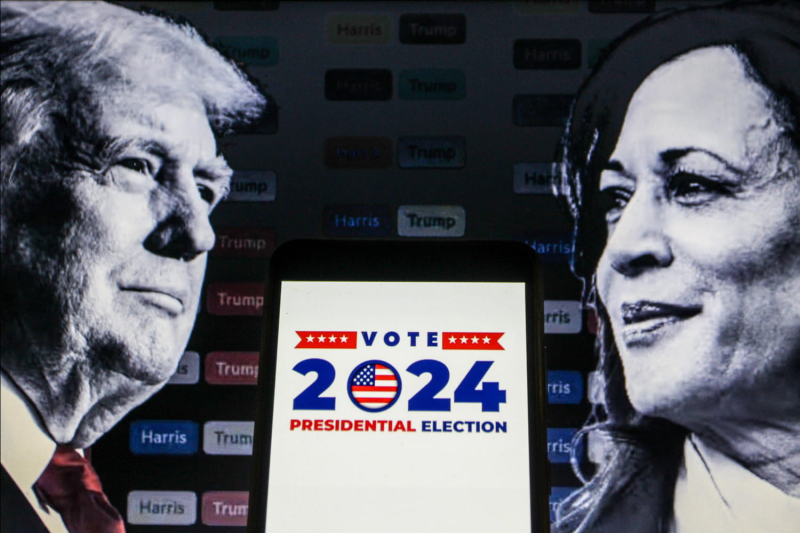
What are the poll results between Donald Trump and Kamala Harris ?
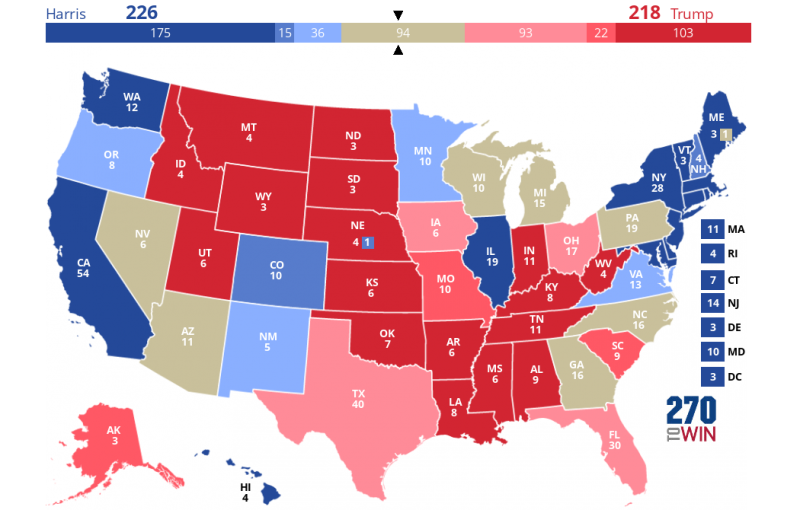
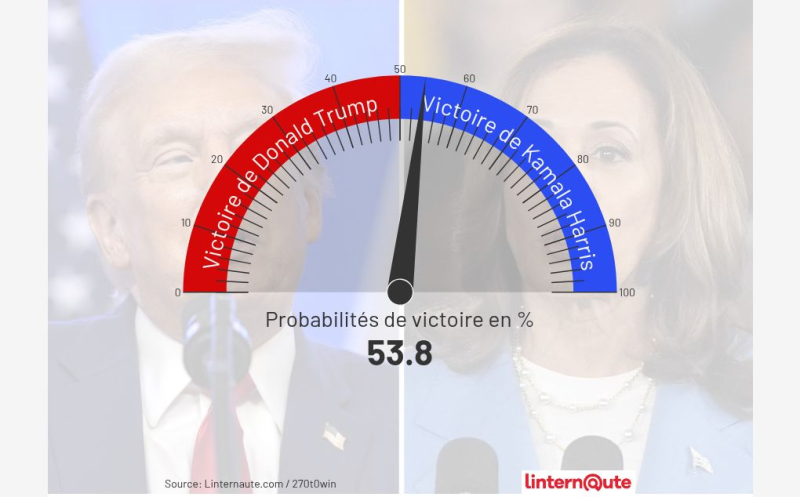
"We are in a plateau phase" in the Harris-Trump campaign
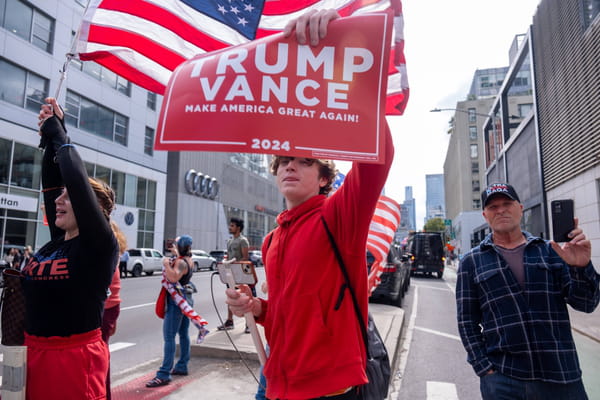
Voting begins in Georgia, already a record turnout
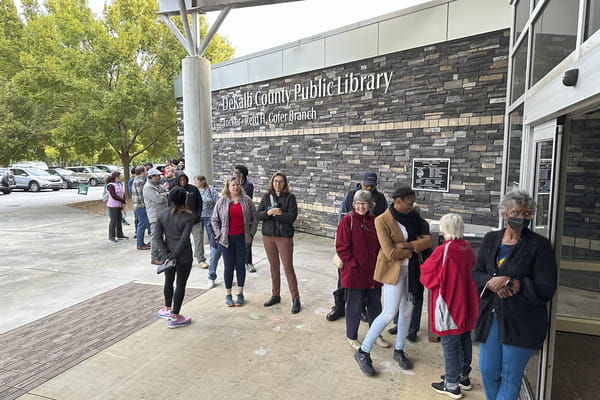
The French want Kamala Harris to win the presidential election
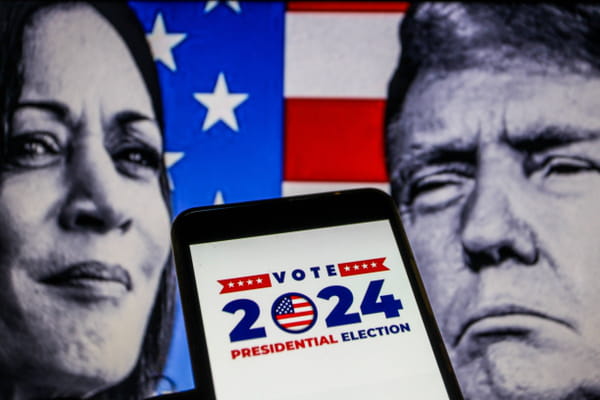
Who votes for Kamala Harris ? Who votes for Donald Trump ?
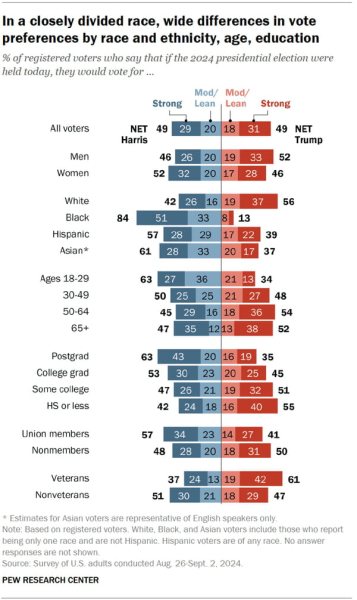
When is the 2024 US presidential election taking place ?
Who are the other candidates for the 2024 american presidential election ?
Apart from the candidates of the two major American parties, one man has entered the presidential race, confident of his chances. Robert Francis Kennedy Jr., nephew of former American president John Fitzgerald Kennedy, is running as an independent candidate. Although he had initially considered participating in the Democratic Party primaries, he ultimately gave up on this possibility. In October 2023, the heir to the famous American dynasty finally ended his campaign to officially support Donald Trump. In the event of a new victory in the presidential election, Donald Trump has also said he is ready to offer the future ex-candidate a position within his administration.
Three other candidates are in the race and are collecting a few crumbs in the voting intentions – which explains why the total between Donald Trump and Kamala Harris is less than 100: Cornel West, candidate of the People's Party, an independent political party; Chase Olivier, the candidate of the Libertarian Party; Randall Terry, candidate of the Constitution Party and Jill Stein, candidate of the Green Party. All these candidates have no chance of being elected, given the weakness of their support and their financing. But above all, American political life is entirely structured around two main parties, the Democrats and the Republicans, which provides a framework that ensures both the predominance of two clearly opposed voices and the assurance of a long-term alternation.
How American elections work ?
The American electoral system is complex. It is based on an indirect system where Citizens do not elect their president directly, but electors who then meet to choose the head of state. This “electoral college” has 538 members, corresponding to the total number of senators and representatives in Congress, as well as three electors for the District of Columbia. Each state has a certain number of electors, allocated according to the size of its population.
In presidential elections, which are held every four years, citizens vote in early November. The candidate who wins a majority of the votes in a state, according to the “winner-takes-all” rule, gets all of the electors in that state, at except for Maine and Nebraska, which distribute their electors proportionally. The candidate who receives at least 270 electors wins the election.

